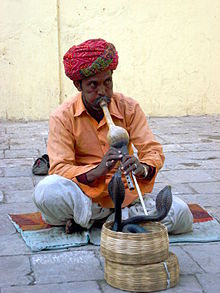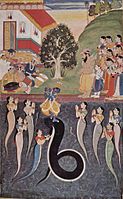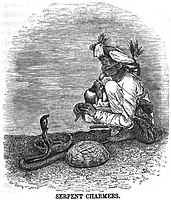Venomous Reptile Thats Also the Name of an Art Movement

Snake charmer in Jaipur (India) in 2008
Snake charming is the do of appearing to hypnotize a serpent (often a cobra) by playing and waving effectually an musical instrument chosen a pungi. A typical performance may also include handling the snakes or performing other seemingly dangerous acts, besides as other street operation staples, like juggling and sleight of hand. The do was historically the profession of some tribesmen in India but this is no longer the example.[one] [2] Serpent-charmer performances still happen in other Asian nations such as Islamic republic of pakistan.[3] People's republic of bangladesh, Sri Lanka and south-e Asian nations like Thailand and Malaysia are also home to performers, every bit are the North African countries of Egypt, Kingdom of morocco and Tunisia.
Ancient Egypt was home to one class of ophidian mannerly, though the practice as it exists today probable arose in India.[ citation needed ] It eventually spread throughout Southeast Asia, the Middle Eastward, and North Africa. Despite a sort of gold age in the 20th century, snake charming is today dying out. This is due to a variety of factors, chief among them is the enforcement of the Wildlife Protection Act, 1972 in India banning ownership of snakes. In retaliation, snake charmers have organized in recent years, protesting the loss of their only means of livelihood, and the government has made some overtures to them. Snake mannerly is almost extinct in India.[one] [iv]
Many snake charmers live a wandering existence, visiting towns and villages on market days and during festivals. During a performance, ophidian charmers may take a number of precautions. The charmer typically sits out of bitter range and the snake is sluggish and reluctant to attack anyway. More drastic means of protection include removing the reptile's fangs or venom glands, or fifty-fifty sewing the snake'south rima oris shut. The almost pop species are those native to the snake charmer's home region, typically diverse kinds of cobras, though vipers and other types are also used.
Although snakes are able to sense audio, they lack the outer ear that would enable them to hear the music. They follow the pungi that the "snake charmer" holds with his hands. The snake considers the person and pungi a threat and responds to it as if it were a predator.
History [edit]

The earliest evidence for snake charming comes from ancient Egyptian sources. Charmers there mainly acted as magicians and healers. Every bit literate and high-status men, part of their studies involved learning the various types of serpent, the gods to whom they were sacred, and how to treat those who were bitten by the reptiles. Entertainment was also function of their repertoire, and they knew how to handle the animals and charm them for their patrons.[ citation needed ]
One of the primeval records of snake charming appears in the Bible in Psalm 58:3–5: "The wicked plow aside from nascency; liars go off-target as shortly as they are born. Their venom is similar that of a serpent, like a deaf serpent that does not hear, that does non respond to the magicians, or to a skilled serpent-charmer."
Snake charming every bit it exists today probably originated in Bharat.[5] Hinduism has long held serpents to be sacred; the animals are believed to be related to the Nagas, and many gods are pictured under the protection of the cobra.
The earliest snake charmers were likely traditional healers by trade. As role of their training, they learned to treat serpent bites. Many also learned how to handle snakes, and people chosen on them to remove snakes from their homes. Baba Gulabgir (or Gulabgarnath) became their guru since his fable states that he taught people to revere the reptiles and not fear them.[ citation needed ] The exercise eventually spread to nearby regions, ultimately reaching North Africa and Southeast Asia.

Snake Charmers in Kolkata, 1945, by Norman Herfort
The early 20th century proved something of a aureate age for snake charmers. Governments promoted the practice to draw tourism, and snake charmers were often sent overseas to perform at cultural festivals and for private patrons. In addition, the charmers provided a valuable source of ophidian venom for creating antivenins.[ citation needed ]
The practice is no longer legal[six] following changes to the Wildlife Protection Act. The law was originally passed in 1972, and aimed at preventing the consign of snakeskins, introducing a seven-year prison term for owning or selling snakes.[7] Beginning in the late 1990s, however, the constabulary was also practical to the serpent charmers. As a upshot, the charmers were forced to move their performances to less-travelled areas such as small villages or face up legal deportment.
In 2003, hundreds of them gathered at the temple of Charkhi Dadri in Haryana to bring international attending to their plight.[viii] In December of the post-obit year, a group of snake charmers stormed the legislature of the Indian state of Odisha with their demands while brandishing their animals. The Indian regime and various animate being-rights groups take now acknowledged the problem. One suggested solution is to train the performers to exist snake handlers, capturing and removing venomous snakes from city and suburban gardens.[9] In return, they could sell their traditional medicines as souvenirs. Some other proposal would try to focus attention on the snake charmers' music and treat them like other street musicians.
Performance [edit]

Snake charmers in Varanasi, Bharat
Snake charmers typically walk the streets property their serpents in baskets or pots hanging from a bamboo pole slung over the shoulder. Charmers comprehend these containers with cloths between performances. Dress in Republic of india, Pakistan and neighbouring countries is by and large the same: long hair, a white turban, earrings, and necklaces of shells or chaplet. Once the performer finds a satisfactory location to ready upwardly, he sets his pots and baskets about him (often with the help of a squad of administration who may exist his apprentices) and sits cross-legged on the ground in forepart of a closed pot or basket. He removes the chapeau, then begins playing a flute-similar instrument made from a gourd, known every bit a been or pungi. As if fatigued by the melody, a snake eventually emerges from the container; if a cobra, it may even extend its hood.
In the Western world snake mannerly is very different. Western-fashion snake charmers use pythons and boa constrictors for their performances equally they are non venomous. Western-mode snake charmers do non employ a musical musical instrument; instead they perform dance routines involving the snakes.[x]
Snakes [edit]
Traditionally, snake charmers use snakes that they accept captured themselves in the wild. This task is non besides difficult, as near South Asian and North African snakes tend to be slow movers.
The exact species of serpents used varies by region. In India, the Indian cobra is preferred, though some charmers may besides use Russell's vipers. Indian and Burmese pythons, and even mangrove snakes are also encountered, though they are not as pop.[ citation needed ] In Northward Africa, the Egyptian cobra, puff adder, carpet viper and horned desert viper are unremarkably featured in performances.[11] In The UK, US and Europe pythons and boa constrictors are used to comply with Fauna Handling and Fauna Welfare Regulations.[x]
Prophylactic measures [edit]
At home, snake charmers keep their animals in containers such as baskets, boxes, pots, or sacks.[ citation needed ]
For safe, some N African snake charmers sew together airtight the mouth of their performing snakes, leaving only enough opening for the brute to be able to movement its natural language in and out. Members of the audience in that region believe that the snake's power to deliver venomous bites comes from its tongue, rather than fangs.[11] Snakes subjected to this practice shortly dice of starvation or oral cavity infection, and must exist replaced by freshly caught specimens.[eleven] Similar methods are used in Bharat, where snakes are defanged and have their venom glands incapacitated.[12] They are then also kept in boxes or bags for thirty–45 days and dehydrated so that their muscles balk (making them sluggish) then that they will drink the milk offered by devotees at festivals (the milk is undigestible to the snake).[thirteen]
Methods of dealing with the fangs include expert surgical removal of both the fangs and replacement fangs, which has been done by some Native American and African ophidian charmers. Barring boggling measures, pulled fangs are replaced within days. Fangs may also be plugged with wax or other material.[14]
In W Africa, charmers have been observed to care for the serpent's trunk and mouth with herbs that paralyze the jaw muscles and cause inflammation of the venom glands.[xiv]
Members of the Pakkoku clan of Burma tattoo themselves with ink mixed with cobra venom on their upper torso in a weekly inoculation which may protect them from the snake, though there is no scientific evidence of that.[14]
Lifestyle [edit]
Snake mannerly is typically an inherited profession. About would-exist charmers thus begin learning the practice at a young age from their fathers. Members of the Sapera or Sapuakela castes, snake charmers have little other choice of profession. In fact, entire settlements of serpent charmers and their families exist in some parts of India and neighbouring countries.[ commendation needed ] In People's republic of bangladesh, ophidian charmers are typically members of the nomadic ethnic group Bede. They tend to live by rivers and employ them to boat to different towns on market days and during festivals.
North African charmers commonly prepare in open-air markets and souks for their performances. In coastal resort towns and well-nigh major tourist destinations one tin encounter ophidian charmers catering to the tourist market, simply in most of the region they perform for the local audiences; an important office of their income comes from selling pamphlets containing diverse magic spells (in detail, of course, against snake bites).[xi]
In previous eras, ophidian mannerly was oftentimes the charmer's only source of income. This is less truthful today, as many charmers also scavenge, scrounge, sell items such as amulets and jewelry, or perform at private parties to make ends meet. Snake charmers are frequently regarded every bit traditional healers and magicians, also, especially in rural areas. These charmers contrive and sell all manner of potions and unguents that purportedly do anything from curing the common cold to raising the expressionless. Villagers and metropolis dwellers alike often call on them to rid of snakes in houses.[ citation needed ]
- Snake charming in art
-

Snakes have long been popular subjects of Hindu fine art, Nāga, c. 1640, (miniature)
-

Snake Charmers [15]
Come across too [edit]
- Venomoid
- Snake handling, a religious ritual
- Worm charming
- Snake Shyam
References [edit]
- ^ a b Chandra, Sharmila (12 November 2013). "India'south snake-charmers sway on the edge of extinction A traditional art form faces extinction". Republic of india Today . Retrieved 16 Apr 2020.
{{cite news}}: CS1 maint: url-condition (link) - ^ Harding, Luke (2 April 2002). "Snake tricks lose their charm". The Guardian . Retrieved 16 April 2020.
{{cite news}}: CS1 maint: url-status (link) - ^ Amtul Jamil (21–27 Dec 2012), "Snakes and charmers", The Friday Times, vol. XXIV, no. 45 . Umerkot is ane of the centers of the craft in Islamic republic of pakistan.
- ^ Harding, Luke (2 Apr 2002). "Snakes tricks lose their charm". The Guardian . Retrieved 16 Apr 2020.
{{cite news}}: CS1 maint: url-status (link) - ^ Powell, Michael; Forbeck, Matt (xviii December 2012). The Most Forbidden Knowledge: 151 Things NO ONE Should Know How to Do. Adams Media. ISBN978-1440560934.
- ^ "Bharat'southward Snake Charmers Work Around Ban", NPR, xiv July 2004
- ^ "Republic of india snake charmers have identity crisis". Los Angeles Times. 21 February 2012. Retrieved 1 February 2020.
- ^ Bezbaruah, Supriya (17 November 2003). "Snake charmers' panchayat demand alternative as govt declare art illegal". India Today . Retrieved eight July 2020.
- ^ "In India, Serpent Charmers Are Losing Their Sway". NPR.org . Retrieved 1 Feb 2020.
- ^ a b Patterson, Alice. "Everything You Demand To Know Well-nigh Serpent Charming". Oddle Entertainment Agency . Retrieved 1 Feb 2020.
{{cite web}}: CS1 maint: url-status (link) - ^ a b c d Highfield, Andy C. and Bayley, Jane R. "Folklore, Myth, and Exploitation of snakes in Morocco and Tunisia". Tortoisetrust.org. Section "Snakes".
- ^ Frederic Friedel (2016). "The ophidian charmer's mortiferous secret".
- ^ "Truth behind Nag Panchami". 2013.
- ^ a b c John C. Murphy (2010). Secrets of the Snake Charmer: Snakes in the 21st Century. iUniverse. ISBN9781450221276.
- ^ "Serpent Charmers". Wesleyan Juvenile Offering. London: Wesleyan Mission House. XXII: 161. November 1865.
External links [edit]
- Cobra Snake Hunting & Ophidian Charmers Performers,Rajasthan
- Snake Chamers Street Performers:Cobra Flute Music
- Rajasthan Ophidian Charmer Profession
- Cobra Dance at Negombo Beach
- YouTube video showing a Kerala Snake charmer
Source: https://en.wikipedia.org/wiki/Snake_charming
0 Response to "Venomous Reptile Thats Also the Name of an Art Movement"
Post a Comment